By Rick Shandley
We spent some time assessing these LOWA Cevedale GTX mountaineering boots. The Cevedale is a heavy-duty, high elevation, all-terrain choice of back country footwear. It’s a boot you might consider for your own adventures, especially if you’re ready to haul heavy backpacks for several days, or take day trips loaded down with ropes, crampons, ice-tools, and general mountaineering gear. If so, the weight can be significant but the Cevedale GTX is up to the challenge.
High elevation mountain trails often have rocky terrain which can be slippery. Because of this, there are innumerable chances to twist your ankle on a missed step or fall. This type of terrain can also make your feet feel flat on the second day out, especially when carrying a heavy backpack and not enough stability in your boots. But this is what the Cevedale GTX is exactly made for.
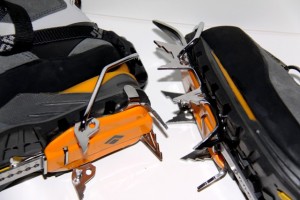
We experienced the boot’s performance during several trips to the Sierra Nevada Range of Eastern California. Here, the Palisade Glacier is good for year-round ice where you can climb and practice mountaineering skills. In this environment, crampons are a necessity. We saw every type of heavy-duty alpine mountaineering boots on hikers going up or coming down the trail. Many hikers are laden with crampons, helmets, rope, and ice axes hanging off the exterior of the packs. Most folks walk the nine miles in from the trail head and stay more than a night as we did. Overnight trekkers must carry a full load of food, water, and enough ice gear to play on the glacier; sometimes with just a pair of crampons and an ice ax. While the beauty of this area is well worth the hike to soak it all in, the Cevedale GTX boots fit right in. We encountered everything from rock, dirt, water and ice, so the Cevedale GTX was in the environment it was designed for.
Alpine activities in mixed terrain, with narrow trails and granite rock in every form, ranging from loose shale crossing slide areas to being up on the glacier, require a solid platform for your footing. Your feet need to be shod in boots that can protect your ankles and foot structure regardless of the terrain type, load size, and weather conditions. We can attest to the ability of the LOWA Cevedale GTX in performing consistently well in each of the conditions we wore them.
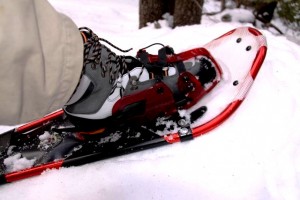
Although the Cevedale GTX performed well in these conditions, we could consider them a three-season mountaineering boot as they are not insulated. We used the boots on snow shoe trips that included overnight hikes into the Sierra Nevada. One night, the winter temperatures sunk rapidly to the low teens. It was at that point where we set the bivouac and because we weren’t generating more heat from movement, we really started feeling the cold. The low temperature made its way down to single digits and it was probably much colder with slight winds blowing. Immediately our toes felt cold so we tucked them straight into the bottom of a Kelty Foraker -15 down sleeping bag to warm up. The boots also went under the sleeping bag to stay as warm as possible overnight. So day trips in winter with high activity are good with the Cevedale GTX for this writer, yet overnight trips in winter would tip the scale towards the LOWA Mountain Expert GTX with Primaloft insulation, or other insulated mountaineering boots.
We used a pair of Crescent Moon Gold Series 10 snowshoes, and Black Diamond stainless steel Sabertooth Pro crampons. LOWA suggests you use combination crampons for the Cevedale GTX boots. The harness system of the Crescent Moon backcountry snowshoes instantly fit these LOWA boots with no issues whatsoever. Likewise with the Black Diamond crampons. It was just a matter of strapping the Cevedale GTX boots into the foot tools to quickly get moving. We absolutely loved this about the boots that also matched the high-quality of the snowshoes and crampons.

LOWA PU Guida midsoles have crampon compatible channels or insert points at the heel and channel grooves, and at the toe of the boot. In general, this groove or channel (also referred to as a heel or toe welt) located at the heel and toe of a mountaineering boot, is a requirement for certain extreme-use crampons. Fortunately the Cevedale GTX can work with several types of crampon design and manufacturers.
The Cevedale GTX boots we tested were worn on late fall backpacking trips all through the winter of 2010 and well into the beginning of spring 2011. The GORE-TEX waterproof liners kept the feet consistently shielded from heavy rain, stream crossings, and wet snow. Even when day temperatures rose, these Cevedale GTX boots continued to keep our feet comfortable and secure.
Although we started wearing them on short trips, (we often like to break-in shoes to find hot spots where blisters would bubble up) these LOWA Cevedale boots did not need breaking in. Our experience with the LOWA Mt. Expert GTX we reviewed last year, pretty much gave us the confidence that the Cevedale GTX boots would not be any different, and we did not develop any blisters or hot-spots.
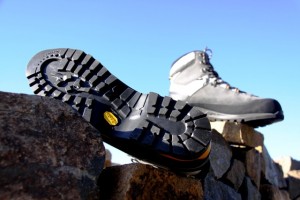
On longer trips, the LOWA Cevedale GTX simply felt like they grew onto our feet. In this writer’s view, once the LOWA’s were laced-on and the pack was cinched to the spine, not much thought was given to the Cevedales, they are always ready to go. At less than two pounds for each foot in a size 14 boot, the perceived weight on the trail was not a factor. These are true mountaineering boots and they are overbuilt. Thank goodness for that. When in full stride, the weight of the boots made long strides on the trails work in favor of forward momentum. There is a slight pendulum affect with mountaineering boots that assists the stride, rather than a feeling of heavy weight on your feet.
It’s during those strides that there’s always a danger that you might step wrong or put your foot into a situation where you can twist your ankle. That’s where the Cevedale support shines. The boot fits snug and the foot protection and sturdy uppers makes what would be a potential ankle turn a non-event. This is especially true with the kind of weight a multi-day backpack will add to your body and also make you much more vulnerable to injury, if not for the protective qualities built into this type of boot.
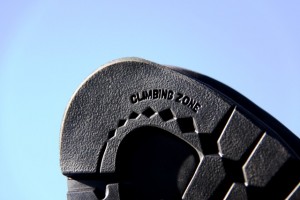
Part of the boot’s suspension is LOWA’s six millimeter thick Nylon TPU foot shank that runs the length of the boot. Sure, you immediately understand these boots are more rigid and supportive than lighter backpack boots. But you want that. If you have ever owned and frequently used mountaineering boots, you expect that stiffness and foot support. The rigidity of the LOWA midsole, its overall boot construction, and Vibram Mulaz out sole is what allows you to carry heavy weights and wear crampons on ice. It’s a requirement of the genre of boot that allows you to get on the mountain and stay there in safety until you are ready to head back to the trail head.
Traction is stable under any terrain condition where you’re not harnessed into crampons or snowshoes. On granite rock and boulder strewn approach routes, the Vibram Mulaz lug pattern, rubber compound type, and the overall traction capability offered good footing.
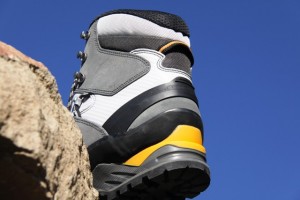
As with the other LOWA mountaineering boots, these same outsoles have the “Climbing Zone” at the toe. The Climbing Zone is a flat area of the forward outsole that permits the climber to get a toe-hold on the surface you are ascending or descending. The toe end of the outsole gives you the stiffness you need to put your weight on, in order to scale the obstacle without giving way or flexing to the degree that you risk being unstable.
While you have the rigidity in all the correct places, you also enjoy good flexibility where you need it. The LOWA 3D Flexfit system allows your heel and ankle the stability you can’t do without, but also provides enough freedom to work with the natural motions of the foot without interference.
Are they comfortable wearing all day? Yes, comfort is awesome and we ended up taking the boot’s comfort for granted. The GORE-TEX interior lining and the breathable footbed managed moisture and ventilation like they are supposed to. We didn’t have any complaints about having uncomfortably hot or sweaty feet. The LOWA C4 boot tongue contours and cradles the front of the foot with excellent padding, as did the overall padding used with the interior of the boot uppers. We did use a set of SOLE Ed Viesturs Reach Higher foot inserts on several occasions for evaluation, and the boots were just as comfortable. With or without aftermarket foot inserts, the Cevedale GTX are comfortable to wear regardless of the length of your trip.
The uppers are split mountaineering leather and micro fiber construction that held up to abrasive contact with rock, and hold the promise of many years of rugged use. LOWA Cevedale GTX boots run about $350.00 per pair, and the color pattern is a combination of dark grey and light grey. As you know, it’s the boot that does the work and not the color options. This color combination works fine because even after quite a few outings the grey, black, and light grey colors still look good. It will be fun to finally see some signs of wear on these boots a couple years down the line from now. Let it be known, this pair of boots will still be getting trail time for years to come.
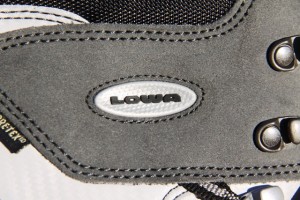
The Cevedale GTX lacing system is made of steel hooks on the top side of the boot and a combination of nylon strap eyelets and a leather eyelet at the forefoot. No question about the ability to snug these boots on your feet and knowing the laces are good and secure. The Tongue Stud/X-Lacing lug does work well for keeping the padded tongue in line with the fore of the foot and evening out the pressure exerted on the foot by cinched-up lacing. Only time will tell if the nylon straps-as-eyelets will hold up well with frequent use. Both the LOWA Mt. Expert GTX, we tested last year, and the Cevedale GTX use this type of lacing system. After more than a year, the Mt. Expert lacing system is unfazed by wear. We would anticipate the same of the Cevedale GTX.
You can see the black high wall rubber rand shoring up the sides of the boot and the heavy-duty truss structure at the heel. All these components and decades of experience in building mountaineering boots are evident in the LOWA Cevedale GTX boots. They have done a great job over several months of wearing them. We like them because they are the kind of boot you can count on to perform well and hold up on a daily or consistent basis. We know they are not insulated, so we keep them in a temperate comfort-zone well above zero. They seem to be ideal for adventurous souls who go up into the higher elevations frequently. These boots are made for people like mountaineering guides, high-country forest service rangers, and those of us who enjoy the upper elevations and all the challenges that come with high country forays. The LOWA Cevedale is a modern day, high-end, mountaineering boot you can have confidence in on high country alpine treks.

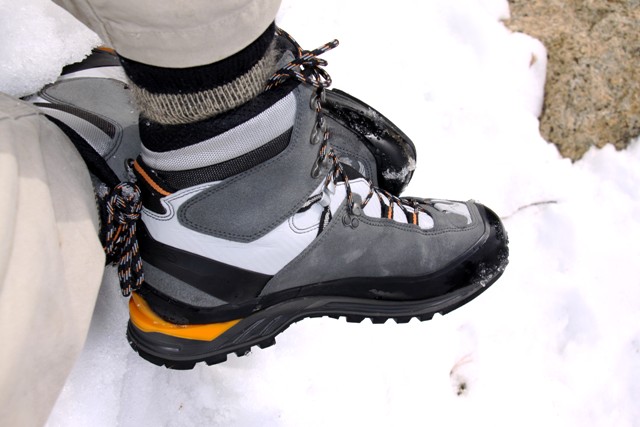


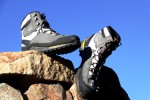




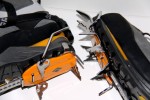



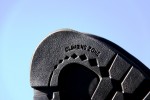
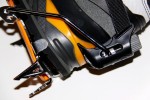
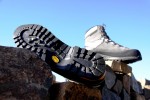
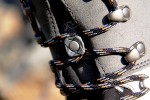


Hello there,
I have now my third pair of lowa cevedale GTX, one thing is fur sure: walking, climbing anything: great , super!!
BUT: they are leaking, getting very wet -inside- !!
That’s why I sent back my first two pairs, and: No problem withing 5 weeks I got one new pair, and for the other another a different pair, but now , this morning after a 5 hour walk , here in the Netherlands, in about 4 hours rain: absolutey soaking wet inside.
How do I keep them dry?
They have Goterexlining and I treated them with ‘Collonil Nanopro’.
Please give me some good advise, cause I really love the way of walking with them, but later this ‘summer’I’m going into the mountains again, and would like to keep some dry feet!
Thanks in advance
many greetings
jules van der steen/ vught/ nl